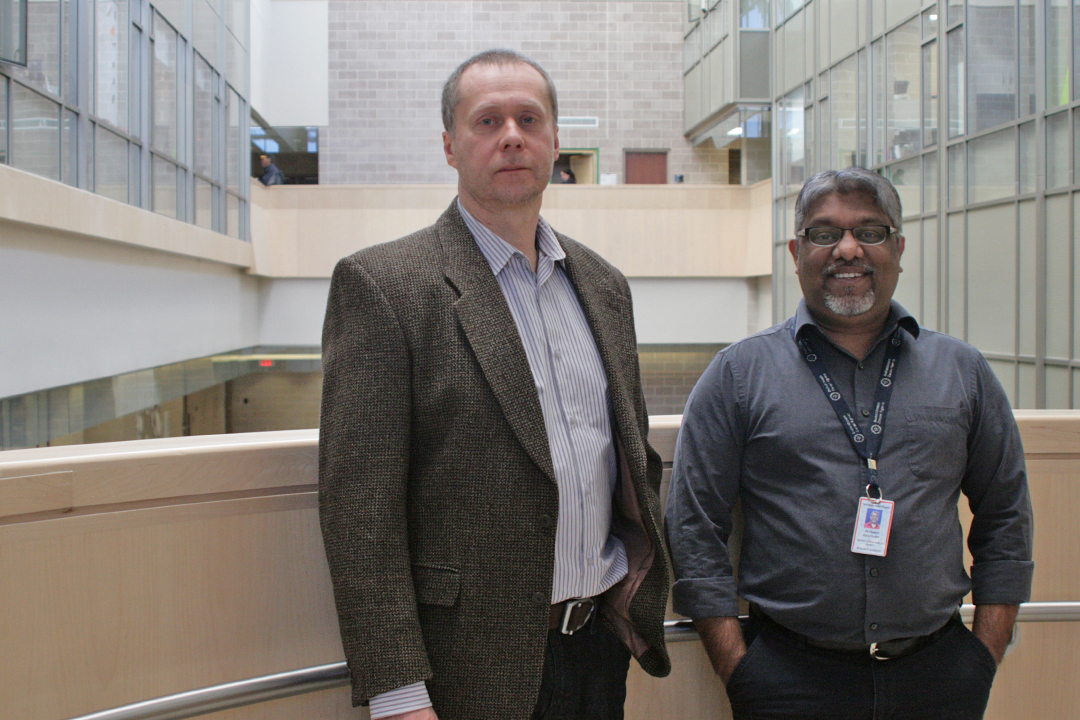
New research could lead to breast cancer treatment
New cancer research being done at the College of Medicine is both a possible game-changer in terms of treating breast cancer, and the first cancer-related investigation being developed from bench-to-trial in the province.
By Marg Sheridan“Several years ago we discovered that a molecule expressed on the surface of cancer cells suppresses the aggressive behavior of breast cancer,” said Andrew Freywald, a pathologist in the College of Medicine and one of the lead researchers on the project. “Breast cancer cells obviously don’t like to have this molecule, because it doesn’t benefit them, so they try to get rid of it. And, according to our analysis, in the majority of breast cancer tumours, the expression of this molecule is (either) missing or down-regulated compared to normal tissues.”
The original research was then published in Cancer Research—a high-impact research journal—before Freywald teamed up with Franco Vizeacoumar from the Division of Oncology and the Saskatchewan Cancer Agency, who is an expert in cancer genomics and systems biology at the College of Medicine.
“We initiated a collaborative project with Professor Vizeacoumar, and his lab performed a genome-wide screen in breast cancer cells and found some molecules that, when inhibited, specifically kill cells that abnormally down-regulate, or lose expression, of this molecule,” continued Freywald. “Because it’s down-regulated in the majority of breast cancer tumours, we can use the inhibition of these molecules to selectively kill breast cancer cells that have down-regulated this molecule, (which) would give us a therapeutic advantage—so we’d have new targets for treating breast cancer.”
“The key is that there are a number of genes like EPHB6 (Ephrin type-B receptor 6), that are differentially regulated in cancer and one of the biggest challenges is to find the way to use that differential regulation to our advantage,” said Vizeacoumar. “So our technology allows us to actually go in and turn off every single gene in the genome, and then ask a question: Which gene should I turn off so that it kills only cancer cells with certain features, without damaging the normal cells?”
Vizeacoumar and Freywald’s team then did an extensive validation of the new target molecules, SRC, which confirmed that inhibiting SRC was selectively killing cells and suppressing breast cancer tumors that had lost EPHB6, while not affecting normal cells or tissues in experimental animals, meaning that it was specifically eliminating breast cancer cells.
“And in this pre-clinical model we found that small molecules, inhibitors of SRC, can be very efficiently used to suppress breast cancer tumours of a very aggressive sub-type called triple negative breast cancer, which currently has no targeted therapy,” Freywald stressed.
And to add to the exciting nature of the promising SRC discovery was the fact that there are already FDA-approved SRC inhibitors, meaning that the research has created a direct path to move from experimental work towards clinical testing.
It’s not an easy, or cheap, process however. The genome-wide screening and validation is an expensive process and so are the studies in pre-clinical models called ‘patient-derived xenografts,’ which, but one upon which the entire cancer research program relies on. As cancer research requires a lot of funding, a lot of clinical trials that are undertaken in Saskatchewan, are usually initiated by researchers from other Canadian or international institutions.
“It’s my understanding that this is the first time that Saskatchewan Cancer Agency will be running a clinical trial initiated from discoveries made in Saskatchewan, to move into a clinical investigation,” explained Vizeacoumar. “So this will be the first bench-to-bedside translation, to happen in Saskatchewan.”
And alongside the recent publication and the patent, the team has filed for their new method of breast cancer treatment, the work has been progressing steadily. The next steps for the team is to come up with a strategy to test the levels of EPHB6 in patients’ tumours to determine, who has lost this molecule, and would therefore benefit from the trial, before they’re able to determine the required sample size.

